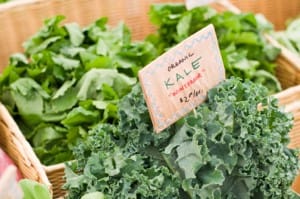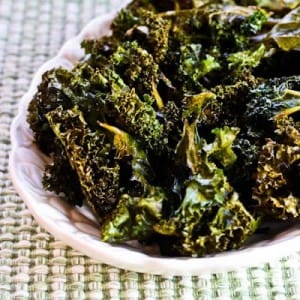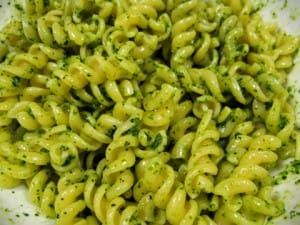Kale is not only one of the more attractive cruciferous vegetables, it also happens to be one of the most nutritious. Here are nine enticing reasons to eat kale, and eat it often!
Kale may appear boring and bland, but there are countless ways to prepare it that are fun and delicious, I promise! See some great kale recipes at the end of this article.

Diet and Digestion
One cup of kale has only 36 calories and zero grams of fat, which makes it a great diet aid. On top of that, one cup contains nearly 20% of the RDA of dietary fiber, which promotes regular digestion, prevents constipation, lowers blood sugar and curbs overeating. One more little fun fact..kale contains the glucosinolate isothiocyanate (ITC) that fights the formation of H. pylori (Helicobacter pylori), a bacterial growth in the stomach lining that can lead to gastric cancer-who woulda thunk it?
Antioxidants-Stay looking younger longer
Kale is a superstar in the arena of carotenoids and flavonoids, two powerful antioxidants that protect our cells from free radicals that cause oxidative stress. The key flavonoids kaempferol and quercitin (not to dismiss the 45 other distinctive flavonoids in kale) have also been shown to specifically fight against the formation of cancerous cells. With the addition of high doses of well-known antioxidants like vitamin C, vitamin A, and manganese, kale is certainly a smart choice in the battle against cellular oxidation.
Anti-Inflammatory
One cup of kale provides about 10% of the RDA of omega-3 fatty acids that helps regulate the body’s inflammatory process. A megadose of vitamin K further aids to fight against excessive inflammatory-related problems, such as arthritis, autoimmune disorders, and asthma.
Cancer
Not only do kale’s antioxidant and anti-inflammatory qualities work together to prevent and even combat cancer, a healthy diet of kale also provides glucosinolates, which have been shown to prevent colon, breast, bladder, prostate, ovarian cancers, as well as gastric cancer.
Cardiovascular Support
The high fiber content of kale lowers our cholesterol by binding with bile acids that the liver produces from cholesterol for digesting fat. Because many of these bile acids are coupled with fiber, the liver is charged with producing more bile acid to digest fat, and therefore requires more cholesterol to so, ultimately lowering the amount of cholesterol within our bodies.
Detox
The isothiocyanates (ITC) from glucosinolates found in kale aid in both phases I and II of the body’s detoxification process. The high sulfur content of kale has further been shown essential for phase II of detoxification.
Vitamin K
Kale provides a whopping dose of vitamin K (providing 1327% of the RDA in one cup), which is necessary for the synthesis of osteocalcin, a protein that strengthens the composition of our bones. Vitamin K also prevents calcium build-up in our tissue that can lead to atherosclerosis, cardiovascular disease and stroke. Finally, vitamin K is essential for synthesizing sphingolipid, the fat needed to maintain the myelin sheath around our nerves, and therefore our nervous system as a whole.
Vitamin A-
With over 192% of the RDA of vitamin A, one cup of kale is an effective antioxidant, boosts immunity, maintains healthy bones and teeth, prevents urinary stones, and is essential to our reproductive organs.
Vitamin C
Vitamin C, which one cup of kale heartily provides (over 88% of our RDA), is not only a powerful antioxidant, but also lowers blood pressure, ensures a healthy immune system, and fights against age-related ocular diseases, such as cataracts and macular degeneration.
—————————————————————————————
A FEW FUN (AND YUMMY!!) KALE RECIPES…
Easy Peasy Kale Chips

Ingredients
- 1 bunch kale
- 1 tablespoon olive oil
- 1 teaspoon seasoned salt
Instructions
Preheat an oven to 350 degrees F (175 degrees C). Line a non insulated cookie sheet with parchment paper.
With a knife or kitchen shears carefully remove the leaves from the thick stems and tear into bite size pieces. Wash and thoroughly dry kale with a salad spinner. Drizzle kale with olive oil and sprinkle with seasoning salt.
Bake until the edges brown but are not burnt, 10 to 15 minutes.
—————————————————————————————
Kale Burger-makes 6 patties
Ingredients
- 1 large bunch kale, well-washed and mostly dried
- sea salt
- 1 large tomato, chopped
- 1 tablespoon almond butter or tahini
- 1/2 teaspoon garlic or 1 clove garlic
- 1/2 teaspoon coriander cayenne to taste (if you like)
- heaping 1/4 cup almond meal heaping
- 1/4 cup flour
- olive oil
- 1 onion
- Goat Cheese (or feta)-optional topping
Instructions
Remove stems and chop kale into very thin ribbons; sprinkle with sea salt and gently massage; let rest 15 minutes. The kale will turn a bright green and soften.
Meanwhile in a food processor or blender combine the tomato, tahini or almond butter, garlic and coriander. If your tomato is not super juicy, add a tablespoon or two of water.
In a large saucepan heat a little oil. Add the kale and saute for a minute; then add 1/2 cup or so of water and cover loosely. Let cook 5 to 8 minutes (the fresher the kale the shorter the cook time) until it’s just wilting but not totally limp. Transfer kale (leave behind any remaining water in the pan) to large bowl.
Meanwhile mix the almond meal and flour in a small bowl. If desired, you could add a little cayenne to this mix too. After it cools enough to handle, add 2/3 of the kale to the blender with the tomato mixture and blend. You don’t want it to get too smooth; maybe pulse on and off for a minute or two.
Transfer this blended mix back into the large bowl with the reserved kale and mix it all together, adding a couple of tablespoons of the flour/almond meal mix too. You should be able to make patties from this mix that hold together fairly well. If too wet, add more flour/almond meal; if too dry, drizzle in some olive oil or water. Form six burgers and coat each burger in the remaining flour/almond meal.
Heat a couple of tablespoons of olive oil over medium heat in a non-stick frying pan. Cook each burger for 4 minutes on each side, adding more oil if need be.
—————————————————————————————
Sesame Kale Salad – serves 4 to 6 as a side dish
Ingredients
- 1 pound of kale leaves once the tough stems & ribs are removed and roughly chopped
- 2 large roasted piquillo peppers or roasted red bell peppers, cut into thin, bite-sized strips
- 3 tablespoons toasted sesame seeds
- 1/4 cup rice wine vinegar
- 2 tablespoons toasted sesame oil
- 2 tablespoons soy sauce
Instructions
In a small bowl, whisk together the sesame oil, soy sauce and vinegar until completely emulsified. Set aside at room temperature.
In a larger mixing bowl, place kale and pepper strips. Drizzle in dressing and mix the greens and dressing thoroughly – I used my hands for this. Sprinkle with toasted sesame seeds and mix once more until evenly distributed. Cover bowl with its lid or well fitting plastic wrap. Chill for 4 hours to overnight.
—————————————————————————————
One Pot Kale and Quinoa Pilaf– Serves 2-4
Ingredients
- 2 cups salted water
- 1 cup quinoa
- 1 bunch lacinato kale, washed and chopped into 1″ lengths
- 1 lemon, zested and juiced
- 2 scallions, minced
- 1 tablespoon coconut oil
- 3 tablespoons toasted pine nuts
- 1/4 cup crumbled goat cheese
- salt and pepper
Instructions
Bring the water to a boil in a covered pot. Add the quinoa, cover, and lower the heat until it is just enough to maintain a simmer. Let simmer for 10 minutes, then top with the kale and re-cover. Simmer another 5 minutes, then turn off the heat and allow to steam for 5 more minutes.
While the quinoa is cooking, take a large serving bowl and combine half of the lemon juice (reserving the other half), all of the lemon zest, scallions, walnut oil (you can substitute olive oil if you desire), pine nuts, and goat cheese.
Check the quinoa and kale when the cooking time has completed — the water should have absorbed, and the quinoa will be tender but firm, and the kale tender and bright green. If the quinoa still has a hard white center, you can steam a bit longer (adding more water if needed). When the quinoa and kale are done, fluff the pilaf, and tip it into the waiting bowl with the remaining ingredients. As the hot quinoa hits the scallions and lemon it should smell lovely. Toss to combine, seasoning with salt and pepper, and the remaining lemon juice if needed.
—————————————————————————————
Kale Walnut Pesto Pasta- Serves 4
 Ingredients
Ingredients
- 1/2 bunch kale, stems discarded and leaves coarsely chopped
- 1 pound gemelli pasta
- 1/4 cup chopped walnuts, toasted
- 1 clove garlic, chopped
- 1/2 cup grated parmesan cheese, plus more for sprinkling
- Salt and pepper
- 1/4 cup extra-virgin olive oil
Instructions
In a large pot of salted water, cook the kale until tender, 4 to 5 minutes. Using a slotted spoon, transfer the kale to a colander and rinse with cold water. Add the pasta to the pot and cook until al dente. Drain, reserving 1/3 cup of the pasta cooking water. Return the pasta to the pot.
Meanwhile, squeeze the kale to remove the excess water. In a food processor, combine the kale, walnuts, garlic and Parmesan until almost smooth; season with salt and pepper. With the machine running, add the olive oil.
Add the pesto to the pasta, along with enough pasta cooking water to loosen the pesto as necessary. Serve sprinkled with more Parmesan.



I love your page! Thank you so much for the time you spent creating a healthy lifestyle.